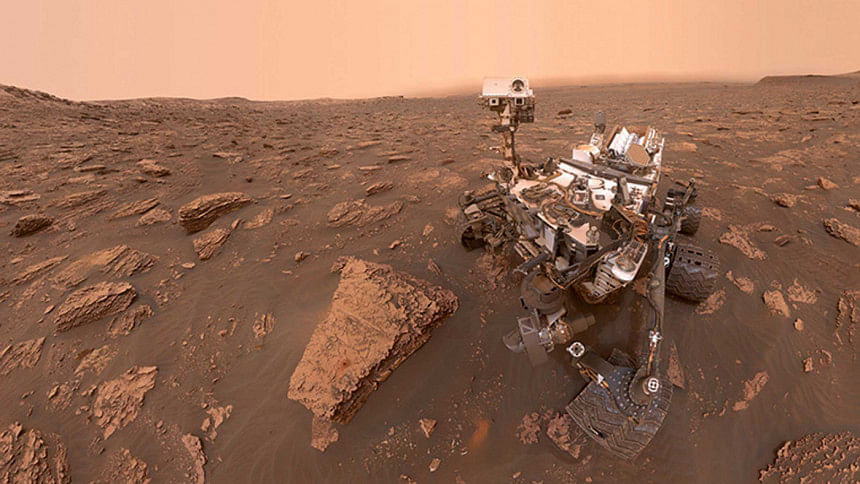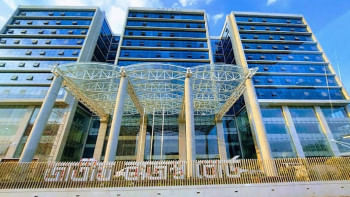Can humans settle on Mars once Earth becomes uninhabitable?

In 1920, American poet Robert Frost mused: "Some say the world will end in fire, some say in ice." Frost held "with those who favour fire." His poetic view unsurprisingly coincides with mainstream scientific consensus about the real prospect of our own annihilation—arising from the incomprehensible scale of problems baked into our future by human-induced climate change. That is why probably a year before his death in 2018, the celebrated British astrophysicist Stephen Hawking issued a grave warning that we must leave the Earth and colonise "other planets in the next century in order to guarantee survival from a variety of threats."
Now that the much-hyped COP26 has ended "not with a bang, but with a whimper," it is time to seriously consider Hawking's suggestion—colonise another planet before the Earth ends in fire.
From The War of the Worlds by HG Wells to The Martian Way by Isaac Asimov, science fiction writers have long been fascinated by the idea of settling on another planet, especially Mars. Science fiction aside, it is indeed the dream of a growing number of scientists and geo-engineers to make Mars inhabitable with some terraforming, a term used to describe transforming another planet into an Earth-like planet.
Why Mars and not the Moon? The Moon, our nearest neighbour in the sky, is impoverished in resources. Furthermore, a day on the Moon is 29.5 Earth days long. Also, the Moon being far less massive than Earth has a weaker surface gravity—about 16 percent that of Earth. For example, a fully suited Apollo astronaut (equipment included) who weighed about 500 pounds on Earth, weighed only about 80 pounds on the Moon.
Why not other planets? The inner planets, Mercury and Venus, are too hot for humans to survive. The Jovian planets, Jupiter outward to Neptune, are gaseous, which means they do not have solid ground to put our feet on.
What makes Mars, which is on the outer boundary of our solar system's habitable zone, a good candidate is its proximity from Earth'closest approach every 15 to 17 years is about 54.6 million kilometres, its day-night cycle is almost the same as ours, with abundant sunshine, and it has a 687-day year with Earth-like four seasons that last twice as long. Although gravity on Mars is 40 percent that of Earth's, it is sufficiently strong to retain an atmosphere and is believed by many to be adequate for the human body to adapt to. Additionally, hydrologic and volcanic processes on Mars are likely to have consolidated various elements into mineral ores that are of interest to an industrial society.
But current conditions on Mars—freezing cold and bereft of such amenities as a breathable atmosphere—are inhospitable for human beings. Nonetheless, in the ancient past, the Red Planet was remarkably habitable, featuring lakes, rivers and an ocean. Things, however, changed dramatically after the planet lost its magnetic field about four billion years ago when its molten iron core froze up. Without a magnetic field, charged particles in the solar wind stripped away Mars' once-thick atmosphere, eventually reducing it to a thin sliver that could no longer retain sufficient heat. As a result, the planet underwent a reverse greenhouse effect.
Today, the greenhouse effect on Mars is extremely inefficient. Its atmosphere, about 100 times thinner than Earth's, is not thick enough to act as a thermal blanket to keep the planet pleasantly warm. Average surface temperature on Mars is a frigid negative 55 degrees Celsius and varies between negative 125 degrees near the poles during winter to positive 20 degrees at the equator during summer. In addition, the atmospheric pressure is less than one percent that of Earth's. Since the atmosphere is excessively thin and cold, Mars cannot support liquid water on its surface, but this does not mean the planet is devoid of it.
Thus, before we colonise Mars, we have to fix the Martian atmosphere and make it hospitable to human life. In particular, we have to raise the planet's temperature to a comfortable level and make the atmosphere thicker. Several possible ways of accomplishing this task have been proposed. Among the many techniques that are on the drawing board, scientists are seriously considering adding temperature-raising gases in its atmosphere, to melting parts of the Martian polar ice caps using giant orbiting mirrors to reflect sunlight, to making the Martian surface non-reflective.
Introduction of fluorine-based compounds that produce a greenhouse effect thousands of times stronger than carbon dioxide is being considered as a long term climate stabiliser. There is also the possibility of in-situ resource utilisation, thanks to NASA's Curiosity Rover discovering subterranean methane, another potent greenhouse gas.
Another element that could play an important role in trapping heat on Mars is aerogel, one of the lightest materials known to humans. Composed of 99 percent air, it is also a good insulator, which is why it is being used in the Rover mission. Using modelling and experiments that mimicked the Martian surface, researchers from the Harvard University, NASA's Jet Propulsion Lab and University of Edinburgh demonstrated that a thin layer of this material increased average temperatures of mid-latitudes on Mars to Earth-like temperatures. Aerogel could also be used to build domes for habitation or self-contained biospheres on the surface of Mars.
If large mirrors can successfully be put into orbit, they will reflect sunlight onto Martian poles, so that carbon dioxide and other greenhouse gases that are believed to be trapped inside the ice will melt and initiate the greenhouse effect. The orbital mirror plan has the advantage of continually introducing extra heat into the Martian climate long after the poles have sublimated.
The idea of coating the surface of Mars with dark materials in order to increase the amount of sunlight it absorbs was first proposed by author and scientist Carl Sagan. The materials could be dust from the Martian moons Phobos and Deimos—two of the darkest objects in the Solar System—or extremophile lichens and plants that are dark in colour.
As noted above, Mars does not have a magnetic field strong enough to shield it from the harmful electrically charged particles in solar wind. Scientists at NASA think that it is possible to deflect the solar wind by positioning powerful magnets at one of the five points in space between Mars and the Sun, known as Lagrange Points, where the gravitational forces and the orbital motion of the magnets would interact to create a stable location. Simulations showed that a shield of this sort would protect Mars from the solar wind.
A new study suggests that Mars could be provided with a magnetic field by creating an artificial ring of charged particles around the planet. This could be done by ionising matter on the surface of its moon, Phobos, which orbits the planet quite closely and makes a trip around it every eight hours. The ionised (electrically charged) particles, when accelerated, would generate an electric current that would give rise to a magnetic field strong enough to protect a terraformed Mars.
How soon can Mars be terraformed? Realistically speaking, once technologies are perfected, it would probably take several centuries for the Martian climate to resemble anything even remotely Earth-like. Will our planet remain habitable for such a long time? That is a moot question.
Finally, it is ironic that many of the approaches to terraform Mars represent the global environmental catastrophe currently causing such concern here on Earth. In view of this, opponents consider terraforming Mars to be the ultimate in "cosmic vandalism." Proponents on the other hand see terraforming as the creation of a new Garden of Eden.
Quamrul Haider is a Professor of Physics at Fordham University, New York.

 For all latest news, follow The Daily Star's Google News channel.
For all latest news, follow The Daily Star's Google News channel. 



Comments